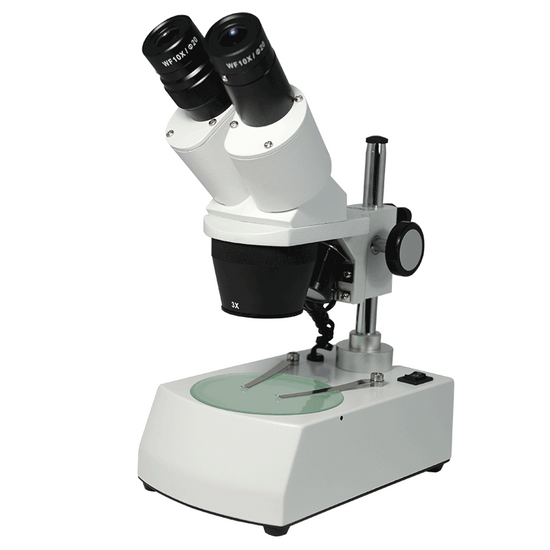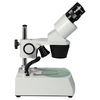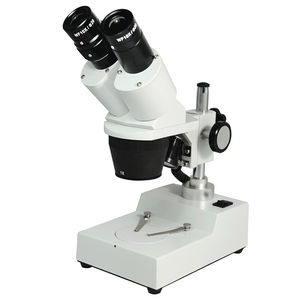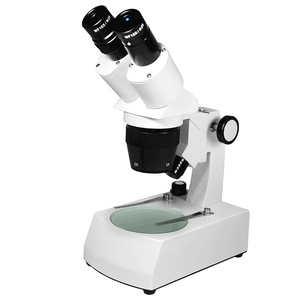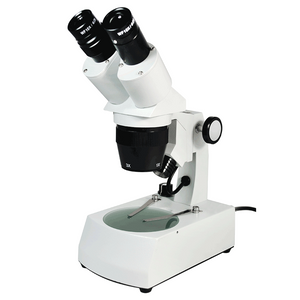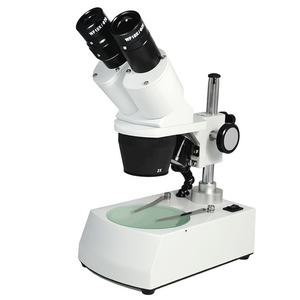Instruction Manual
FS1201-FS1211_Stereo_Microscope__Instruction_Manual-English.doc
Quick Overview
Finite. Total Magnification: 10X/30X. 10X Eyepiece. 1/3X Objective . Binocular. Eye Tube Angle: 45°. Eyepiece Field of View: Dia. 20mm. Post Stand. Illumination Type: LED Dual Illuminated Light . Top Illumination: Oblique Top Light. Input Voltage: AC 100-240V 50/60Hz.
Suggested Applications
Environmental , Field Research, Jewelry & Gemology , Appraisal
FS1201-FS1211_Stereo_Microscope__Instruction_Manual-English.doc
Quick Overview
Finite. Total Magnification: 10X/30X. 10X Eyepiece. 1/3X Objective . Binocular. Eye Tube Angle: 45°. Eyepiece Field of View: Dia. 20mm. Post Stand. Illumination Type: LED Dual Illuminated Light . Top Illumination: Oblique Top Light. Input Voltage: AC 100-240V 50/60Hz.
Suggested Applications
Environmental , Field Research, Jewelry & Gemology , Appraisal
FS12110227 10X/30X Binocular Dual Power Stereo Microscope
Optical System Specifications
| Optical System | Finite |
| System Optical Magnification | 10X/30X |
| Total Magnification | 10X/30X |
| Standard Eyepiece | 10X Eyepiece |
| Standard Objective | 1/3X Objective |
| System Field of View | Dia. 6.7mm/ Dia. 20mm |
| System Working Distance | 59mm |
Binocular Dual Power Body
| Body Optical System | Finite |
| Body Magnification | 10X/30X |
| Power Change Mode | With the Nosepiece |
| Observation Method | Binocular |
| Eye Tube Adjustment Mode | Siedentopf |
| Eye Tube Angle | 45° |
| Erect/Inverted Image | Erect image |
| Eye Tube Rotatable | Fixed |
| Interpupillary Adjustment | 48-75mm |
| Eye Tube Inner Diameter | Dia. 30.5mm |
| Eye Tube Diopter Adjustable | Left ±5°, Right Not Adjustable |
| Eye Tube Fixing Mode | Locking Screw |
| Eyepiece Type | Standard Eyepiece |
| Eyepiece Optical Magnification | 10X |
| Plan Eyepiece | Plan Eyepiece |
| Eyepiece Size for Eye Tube | Dia. 30.5mm |
| Eyepiece Field of View | Dia. 20mm |
| Eyepoint Type | High Eyepoint Eyepiece |
| Objective Working Distance | 59mm |
Post Stand
| Stand Type | Post Stand |
| Vertical Post Height | 155mm |
| Vertical Post Diameter | Dia. 14mm |
| Base Type | Illumination Base |
| Base Shape | Rectangle |
| Base Dimensions | 190x115x55mm |
| Focus Mode | Manual |
| Focus Distance | 40mm |
| Coarse Focus Distance per Rotation | 18mm |
| Illumination Type | LED Dual Illuminated Light |
| Top Illumination | Oblique Top Light |
| Top Illumination Type | LED |
| Bottom Illumination Type | LED |
Power Supply
| Input Voltage | AC 100-240V 50/60Hz |
| Output Voltage | DC 4.5V |
| Power Cord Connector Type | CN 2 Pins |
| Power Cable Length | 1.5m |
| Battery | AA (Included Three Batteries) |
Other Parameters
| Surface Treatment | Spray Paint |
| Material | Metal |
| Color | White |
| Net Weight | 2.22kg (4.89lbs) |
| Dimensions | 190x115x280mm (7.480x4.528x11.024 in. ) |
Series
| FS1211 | FS12110227 |
Technical Info
Instructions
Stereo MicroscopeClose Λ
| Stereo microscopes are also known as the anatomical microscopes, or dissecting microscopes. Many people would refer to stereo microscope as Stereo, and the Continuous Zoom Microscope as Zoom. Stereo microscopes are a kind of binocular microscope that observes an object with both eyes from different angles, thereby causing a stereoscopic effect. The stereo microscope adopts two independent optical paths, and the left and right beams in the binocular tube have a certain angle, generally 12°~15°. The objects are observed from different angles of the two optical paths, causing a three-dimensional effect on the eyes, and therefore a stereo microscope is a true 3D microscope. Compared with other compound microscopes, stereo microscopes belong to the low power optical microscope. The field of view of stereo microscopes has a large diameter, its magnification is generally below 200X for optical magnification. When the magnification is greater than 40X, the stereoscopic effect of the image will be relatively poor. Therefore, the advantage of the stereo microscope is not that its magnification is large, but that its working distance is long and the depth of field is large, which is particularly suitable for observing objects with a high degree of three-dimensional features. For compound microscope with a single optical path, what we see is only a flat image. Although most compound microscopes have two eyepieces, what we actually see is one and the same image, and this is just to facilitate the observation habits of our two eyes. The stereo microscope has two optical paths (two objective lenses or one common objective lens), and only the three-dimensional sense produced under observation of the two optical paths can make people judge the three-dimensional spatial position of the observed object, which can generate a sense of distance under the microscope. Therefore, only stereo microscope can be used for operation under the microscope which is very suitable for surgery, dissection, industrial welding, assembly, precision instrument repair and so on. The stereo microscope can be equipped with a wide range of accessories. It can be combined with various digital cameras and photographic interfaces, microscope cameras, eyepiece cameras and image analysis software to form a digital imaging system. It can be connected to a computer for analysis and processing, and its lighting system also has different options for illumination, such as reflected light, transmitted light, etc. Stereoscopic microscopes are widely used in various fields, such as biology, medicine, agriculture, forestry, marine life, and other various departments. They are especially used in industry, for macroscopic surface observation, analysis, and microscopic operations. Stereoscopic microscopes were invented by American instrument engineer Horatio S. Greenough in the 1890s, manufactured by Carl Zeiss Company of Germany, and are widely used in scientific research, archaeological exploration, industrial quality control, biopharmaceuticals, and more. Stereo Microscope Quick Operation Steps Step 1 In the working position, place the microscope on the workbench after installation. Connect the power source, and turn on the light source. Place an observation sample (also known as specimen) such as a coin etc. under the microscope or on the base. Adjust the focus knob of the stand by visually measuring the height, or based on the working distance parameters of the objective lens used. Step 2 Adjust the zoom knob of the microscope to the lowest magnification. Find the approximate image by adjusting the focus knob. Find a certain feature point of the sample in approximately the center position. Align the feature point of the specimen and gradually adjust to a large magnification. Adjust the lift set of the microscope to find the focal plane of the highest magnification. During the adjustment process, use a sample with obvious feature points (such as a coin) to compare the sharpness of the image. Turn the zoom knob again to the lowest magnification. It is possible that the image may be out of focus. At this time, do not adjust the focusing knob. Simply adjust the diopters on the two eyepieces to accommodate differences in eye observations (diopter varies from person to person). Adjust the viewing distance of the eyepiece to achieve a comfortable position. At this point, the microscope is already parfocal, i.e., when the microscope is changed from high power to low power, the entire image is in the focal plane. To observe the same sample, it is not necessary to adjust other parts of the microscope. Only the zoom knob is needed to zoom in on the specimen for observation. Step 3 Adjust the light source, including the brightness and angle of incidence to get the best image or see additional details. Step 4 Adjust any other necessary equipment such as the photographic eyepieces, cameras, etc., to show the image on the display or to find the sharpest image. When using binocular observation and the left and right images or sharpness is not the same, first adjust the diopter adjustment on the eyepiece. This adjusts the parallax of the two eyes, so that the image of the two eyes are consistent. It is normal to feel viewing fatigue when using a microscope for a long time. Take a break before working again to adapt your eyes to using the microscope. If the microscope is used for too long, or if there is a problem inside the microscope due to large temperature difference, vibration, etc., please contact your dealer or our service staff on the BoliOptics website. |
FiniteClose Λ
| Microscopes and components have two types of optical path design structures. One type is finite optical structural design, in which light passing through the objective lens is directed at the intermediate image plane (located in the front focal plane of the eyepiece) and converges at that point. The finite structure is an integrated design, with a compact structure, and it is a kind of economical microscope. Another type is infinite optical structural design, in which the light between the tube lens after passing the objective lens becomes "parallel light". Within this distance, various kinds of optical components necessary such as beam splitters or optical filters call be added, and at the same time, this kind of design has better imaging results. As the design is modular, it is also called modular microscope. The modular structure facilitates the addition of different imaging and lighting accessories in the middle of the system as required. The main components of infinite and finite, especially objective lens, are usually not interchangeable for use, and even if they can be imaged, the image quality will also have some defects. The separative two-objective lens structure of the dual-light path of stereo microscope (SZ/FS microscope) is also known as Greenough. Parallel optical microscope uses a parallel structure (PZ microscope), which is different from the separative two-object lens structure, and because its objective lens is one and the same, it is therefore also known as the CMO common main objective. |
System Optical MagnificationClose Λ
| The magnification of the objective lens refers to the lateral magnification, it is the ratio of the image to the real size after the original image is magnified by the instrument. This multiple refers to the length or width of the magnified object. System optical magnification is the product of the eyepiece and the objective lens (objective lens zoom set) of the optical imaging part within the system. Optical magnification = eyepiece multiple X objective lens/objective lens set The maximum optical magnification of the microscope depends on the wavelength of the light to which the object is illuminated. The size of the object that can be observed must be greater than the wavelength of the light. Otherwise, the light cannot be reflected or transmitted, or recognized by the human eye. The shortest wavelength of ultraviolet light is 0.2 microns, so the resolution of the optical microscope in the visible range does not exceed 0.2 microns, or 200 nanometers. This size is converted to the magnification of the microscope, and it is the optical magnification of 2000X. Usually, the compound microscope can achieve 100X objective lens, the eyepiece is 20X, and the magnification can reach 2000X. If it is bigger, it will be called "invalid magnification", that is, the image is large, but the resolution is no longer increased, and no more details and information can be seen. |
Total MagnificationClose Λ
| Total magnification is the magnification of the observed object finally obtained by the instrument. This magnification is often the product of the optical magnification and the electronic magnification. When it is only optically magnified, the total magnification will be the optical magnification. Total magnification = optical magnification X electronic magnification Total magnification = (objective X photo eyepiece) X (display size / camera sensor target ) |
System Field of ViewClose Λ
| Field of View, is also called FOV. The field of view, or FOV, refers to the size of the object plane (i.e., the plane of the point of the observed object perpendicular to the optical axis), or of its conjugate plane (i.e., object to primary image distance), represented by a line value. System field of view is the size of the actual diameter of the image of the terminal display device of the instrument, such as the size of the image in the eyepiece or in the display. Field of view number refers to the diameter of the field diaphragm of the objective lens, or the diameter of the image plane formed by the field diaphragm. Field of view number of objective lens = field of view number of eyepiece / (objective magnification / mechanical tube length) Large field of view makes it easy to observe the full view and more range of the observed object, but the field of view (FOV) is inversely proportional to the magnification and inversely proportional to the resolution, that is, the larger the field of view, the smaller the magnification, and also the lower the resolution of the object to be observed. There are usually two ways to increase the field of view, one is to replace with an objective lens of a smaller multiple, or to replace with an eyepiece of a smaller multiple. |
System Working DistanceClose Λ
| Working distance, also referred to as WD, is usually the vertical distance from the foremost surface end of the objective lens of the microscope to the surface of the observed object. When the working distance or WD is large, the space between the objective lens and the object to be observed is also large, which can facilitate operation and the use of corresponding lighting conditions. In general, system working distance is the working distance of the objective lens. When some other equipment, such as a light source etc., is used below the objective lens, the working distance (i.e., space) will become smaller. Working distance or WD is related to the design of the working distance of the objective lens. Generally speaking, the bigger the magnification of the objective lens, the smaller the working distance. Conversely, the smaller the magnification of the objective lens, the greater the working distance. When it is necessary to change the working distance requirement, it can be realized by changing the magnification of the objective lens. |
Binocular Dual Power BodyClose Λ
| Binocular dual power body refers to the main body of a stereo microscope with two objective lens magnifications. When performing magnification-shifting, two different magnifications can be obtained. When the body needs other different magnifications, it can also be solved by adding or changing the objective lens/auxiliary objective lens, or by changing the eyepieces of different magnifications. Dual power stereo microscope mostly uses 10X, 20X, 30X, 40X combinations of two kinds of magnifications. When the magnification is greater than 40X, the image is close to the plane effect, and the stereoscopic effect is relatively poor. Dual power stereo microscope has a simple structure, high reliability and low cost, it is a kind of stereo microscope that can satisfy stereo image applications. |
With the NosepieceClose Λ
| When the microscope body changes the magnification, it is realized by adjusting the zoom drum or nosepiece. Generally, the lower case of the microscope is used as the zoom drum or nosepiece. When magnification conversion is required, it can be realized by turning the zoom drum or nosepiece. |
SiedentopfClose Λ
| For siedentopf eyetube, when changing the interpupillary distance, it requires two hands pushing or pulling the two eyetubes left and right simultaneously, and the two eyepiece tubes or eyetubes will change their position at the same time. |
Eye Tube AngleClose Λ
| Usually the Microscope Eyetube is 45°, some is 30°, Tiltable Eyetube Angle design of a microscope is also known as the ergonomics microscope. 0-30° or 0-45° is an ergonomic design. When the mechanical tube length / focal length of the tube of the microscope is relatively big, the microscope is relatively high, and the user's height or the seat of the work desk is not suitable, long-term use of microscope may cause sitting discomfort. Eyepiece tube with variable angle can freely adjust the angle without lowering the head. Especially when it is close to 0 degree and the human eye is close to horizontal viewing, long-time or long-term use can avoid fatigue damage to the cervical vertebra. |
Erect/Inverted ImageClose Λ
| After imaging through a set of objective lenses, the object observed and the image seen by the human eye is inverted. When the observed object is manipulated, move the specimen or object, the image will move in the opposite direction in the field of view. Most of the biological microscopes are reversed-phase designs. When needing to operate works with accurate direction, it is necessary to design it into a forward microscope. Generally stereo microscopes and metallurgical microscopes are all of erect image design. When observing through the camera and display, the erect and inverted image can be changed by the orientation of the camera. |
Interpupillary AdjustmentClose Λ
| The distance between the two pupils of the human eye is different. When the image of exit pupil of the two eyepieces of the microscope are not aligned with the entry pupil of the eye, the two eyes will see different images, which can cause discomfort. Adjust the distance between the two eyepieces, to accommodate or adapt to the pupil distance of the observer's eyes. The adjustment range is generally between 55-75mm. |
Eye Tube Diopter AdjustableClose Λ
| For most people, their two eyes, the left and the right, have different vision; for the eyepiece tube, the eyepoint height of the eyepiece can be adjusted to compensate for the difference in vision between the two eyes, so that the imaging in the two eyes is clear and consistent. The range of adjustment of the eyepiece tube is generally diopter plus or minus 5 degrees, and the maximum differential value between the two eyepieces can reach 10 degrees. Monocular adjustable and binocular adjustable: some microscopes have one eyepiece tube adjustable, and some have two eyepiece tubes adjustable. First, adjust one eyepiece tube to the 0 degree position, adjust the microscope focusing knob, and find the clear image of this eyepiece (when the monocular adjustable is used, first adjust the focusing knob to make this eyepiece image clear), then adjust the image of another eyepiece tube (do not adjust the focusing knob again at this time), repeatedly adjust to find the clear position, then the two images are clear at the same time. For this particular user, do not adjust this device anymore in the future. As some microscopes do not have the vision adjustment mechanism for the eyepiece tube, the vision of the two eyes are adjusted through the eyepiece adjustable. |
Eyepiece Optical MagnificationClose Λ
| Eyepiece optical magnification is the visual magnification of the virtual image after initial imaging through the eyepiece. When the human eye observes through the eyepiece, the ratio of the tangent of the angle of view of the image and the tangent of the angle of view of the human eye when viewing or observing the object directly at the reference viewing distance is usually calculated according to 250 mm/focal length of eyepiece. The standard configuration of a general microscope is a 10X eyepiece. Usually, the magnification of the eyepiece of compound microscope is 5X, 8X, 10X, 12.5X, 16X, 20X. As stereo microscope has a low total magnification, its eyepiece magnification generally does not use 5X, but can achieve 25X, 30X and other much bigger magnification. |
Eyepiece Field of ViewClose Λ
| The eyepiece field of view is the diameter of the field diaphragm of the eyepiece, or the diameter of the image plane of the field diaphragm imaged by the field diaphragm. The diameter of a large field of view can increase the viewing range, and see more detail in the field of view. However, if the field of view is too large, the spherical aberration and distortion around the eyepiece will increase, and the stray light around the field of view will affect the imaging effect. |
Eyepoint TypeClose Λ
| Eye point refers to the axial distance between the upper end of the metal frame of the eyepiece and the exit of pupil. The exit of pupil distance of high eyepoint eyepiece is farther than that of the eye lens of the ordinary eyepiece. When this distance is greater than or equal to 18mm, it is a high eyepoint eyepiece. When observing, one does not need to be too close to the eyepiece lens, making it comfort to observe, and it can also be viewed with glasses. Generally, there is a glasses logo on the eyepiece, indicating that it is a high eyepoint eyepiece. |
Objective Working DistanceClose Λ
| The objective working distance is the vertical distance from the foremost surface end of the objective of the microscope to the object surface to be observed. Generally, the greater the magnification, the higher the resolution of the objective, and the smaller the working distance, the smaller the field of view. Conversely, the smaller the magnification, the lower the resolution of the objective, and the greater the working distance, and greater the field of view. High-magnification objectives (such as 80X and 100X objectives) have a very short working distance. Be very careful when focusing for observation. Generally, it is after the objective is in position, the axial limit protection is locked, then the objective is moved away from the direction of the observed object. The relatively greater working distance leaves a relatively large space between the objective and the object to be observed. It is suitable for under microscope operation, and it is also easier to use more illumination methods. The defect is that it may reduce the numerical aperture of the objective, thereby reducing the resolution. |
Post StandClose Λ
| Post stand generally has relatively tall post. When the focus is adjusted, the focusing mechanism can slide up and down the post, the microscope is thus placed in an approximately focused position, and then the focusing mechanism makes fine and accurate adjustment. This kind of stand can move quickly, and is suitable for viewing objects with a higher height and bigger volume. After the microscope is mounted, the microscope imaging center needs to be aligned with the center of the platen. The focusing mechanism button on the post must be tightened to lock the guard ring device, and the microscope should be prevented from loosening and shaking when working. When it is necessary to adjust the height, hold the microscope and the focusing mechanism with one hand, then release the knob, adjust it to the proper position, lock the knob, then top the guard ring to the lower position of the focusing mechanism, and lock it tight. In particular, avoid accidental dropping of the microscope due to gravity, thereby damaging the microscope and the objects below. |
Illumination BaseClose Λ
| Illumination base is a modular light source component, suitable for microscope stand base that has no light source of itself, and it is usually dedicated components supporting some stands. Illumination base typically includes at least one bottom lighting, and there are also illumination base that includes the circuit portion of the upper light source. |
PackagingClose Λ
| After unpacking, carefully inspect the various random accessories and parts in the package to avoid omissions. In order to save space and ensure safety of components, some components will be placed outside the inner packaging box, so be careful of their inspection. For special packaging, it is generally after opening the box, all packaging boxes, protective foam, plastic bags should be kept for a period of time. If there is a problem during the return period, you can return or exchange the original. After the return period (usually 10-30 days, according to the manufacturer’s Instruction of Terms of Service), these packaging boxes may be disposed of if there is no problem. |
| Contains | |
| Parts Including | |
| Desiccant Bag | 1 Bag |
| Allen Key | M1 1pc |
| Dust Cover | 1pc |
| Product Instructions/Operation Manual | 1pc |
| Packing | |
| Packaging Type | Carton Packaging |
| Packaging Material | Corrugated Carton |
| Packaging Dimensions(1) | 30x17x35cm (11.811x6.693x13.780″) |
| Inner Packing Material | Plastic Bag |
| Ancillary Packaging Materials | Expanded Polystyrene |
| Gross Weight | 2.58kg (5.69lbs) |
| Minimum Packaging Quantity | 1pc |
| Transportation Carton | Carton Packaging |
| Transportation Carton Material | Corrugated Carton |
| Transportation Carton Dimensions(1) | 30x17x35cm (11.811x6.693x13.780″) |
| Total Gross Weight of Transportation(kilogram) | 2.58 |
| Total Gross Weight of Transportation(pound) | 5.69 |
 |

